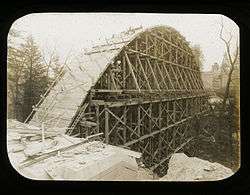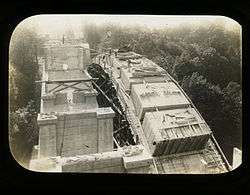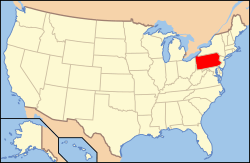Walnut Lane Bridge
The Walnut Lane Bridge is a concrete arch bridge located in Northwest Philadelphia that connects the Germantown and Roxborough neighborhoods across the Wissahickon Creek in Fairmount Park.[3] While drivers may cross the bridge too quickly to notice, the view from underneath the bridge has inspired many artists and writers, such as Christopher Morley.[4] The design was copied from Pont Adolphe in Luxembourg.[5]
Walnut Lane Bridge | |
|---|---|
.jpg) | |
| Coordinates | 40°01′55″N 75°12′00″W |
| Crosses | Wissahickon Creek |
| Locale | Philadelphia, Pennsylvania |
| Maintained by | City of Philadelphia |
| Characteristics | |
| Design | concrete |
| Total length | 585 feet (178 m) |
| Width | 48 feet (15 m) |
| Height | 147 feet (45 m) |
| Longest span | 233 feet (71 m) |
| History | |
| Construction cost | $260,000 ($5 Million Today) |
| Opened | October 14, 1908 |
Walnut Lane Bridge | |
| Location | Philadelphia, Pennsylvania United States |
| Coordinates | 40°01′56″N 75°11′59″W |
| Built | 1907 |
| Architect | George S. Webster (chief) Henry H. Quimby (assistant) |
| NRHP reference No. | 88000815[1] |
| Significant dates | |
| Added to NRHP | May 10, 1988 |
| Designated PHMC | October 18, 2008[2] |

| |
The Walnut Lane Bridge was added to the National Register of Historic Places in 1988.[6]
Construction
Construction began on July 5, 1906 and was completed on October 14, 1908. Over 40,000 tons of rubble concrete (containing a great amount of large stones, for greater shear strength) were poured into the falsework, which had been built from steel bents 20 feet (6.1 m) high and 370,000 board feet (870 m3) of timber, weighing about 900 tons.[7] The bridge's six spans total 585 ft in length (178 m). Very little use was made of reinforcing steel, which was scarce at the time. The roadway is 40 ft (12 m) wide, flanked by 10-foot (3.0 m) reinforced-concrete sidewalks and pre-cast concrete balustrades.[8]
The chief engineer was George S. Webster, assisted by Henry Quimby, both of the Philadelphia Department of Public Works. At the time of its construction, the bridge was the longest and highest concrete arch bridge in the world.[9] While $240,000 was originally committed to the project, the figure rose to nearly $260,000 by completion (equivalent to nearly $6 million in 2008).
City Beautiful Movement
The bridge was a direct product of the City Beautiful Movement in Philadelphia in the early years of the 20th century. Seeking to provide community harmony and cooperation through improved public spaces, the bridge was viewed as an achievement that could unite the communities and cultures of Roxborough and Germantown in addition to inspiring a greater civic engagement. It was also believed that more beautiful construction techniques could help to reform a corrupt political system within the city. The Philadelphia community members rallied around the construction of the bridge and the opening was highly anticipated by all ages alike.
Opening
The bridge was opened on October 14, 1908 and was formally dedicated on December 16 of the same year. Students from nearby schools participated in the dedication ceremony by marching toward the middle of the bridge and singing "Hail Philadelphia."[10] The ceremony ended with a reception at a local inn with the traditional Wissahickon meal of catfish and waffles.
Other bridges confused with the Walnut Lane Bridge
The Walnut Lane Bridge is often confused with other bridges in Philadelphia that are similar in name and construction. The Walnut Street Bridge crosses the Schuylkill River and connects University City, Philadelphia and Center City, Philadelphia. The nearby Wissahickon Memorial Bridge (aka Henry Avenue Bridge), which connects the East Falls and Roxborough neighborhoods of Philadelphia, is also often mistaken for the Walnut Lane Bridge. But the bridge most often confused with the Walnut Lane Bridge is the Walnut Lane Memorial Bridge, which replaced a cast-iron bridge over the Monoshone Creek and Lincoln Drive in Philadelphia in 1950 and is world-famous as a pre-stressed, post-tension concrete bridge.[11]
Tragedy at the Walnut Lane Bridge

The Walnut Lane Bridge has a history of tragedies and deaths since construction began in 1906. In December 1907, the falsework (used to support the forms for pouring concrete) collapsed and sent about 20 workers plunging 150 feet (46 m) into the Wissahickon Creek. Martin Simpson was listed as the only worker to die during the tragedy while Bernard Mers lost an arm and James Lawson had both of his hands crushed. The crash drew neighbors out of their homes, as the sound could be heard throughout the valley.
Throughout the rest of the 20th century, stories of car crashes and suicides abound for the Walnut Lane Bridge. It was a common occurrence to see pictures of the bridge in the newspapers with a dotted line showing the path of a person's fall.[12][13]
Centennial celebration

In 2008, Cliveden, a National Historic Landmark and museum in Germantown owned by the National Trust for Historic Preservation, celebrated the 100th anniversary of the completion of the bridge. Only a few blocks from the Walnut Lane Bridge, Cliveden hosted an exhibition and educational program on the construction of the bridge, featuring a collection of rare lantern slides. The exhibit ran from May through October.[14]
See also
- List of bridges documented by the Historic American Engineering Record in Pennsylvania
- Adolphe Bridge, a bridge in Luxembourg built in 1903 that served as model for the Walnut Lane Bridge.
References
- NRHP Listings
- "PHMC Historical Markers". Historical Marker Database. Pennsylvania Historical & Museum Commission. Archived from the original on December 7, 2013. Retrieved December 10, 2013.
- Fairmount Park at AOL Local Life
- Morley, from "Up the Wissahickon," in Christopher Morley's Philadelphia (New York: Fordham Press, 1990) 217-218.
- "Walnut Lane Bridge". Structurae. Retrieved 2006-08-03.
- "National Register Information System". National Register of Historic Places. National Park Service. April 15, 2008.
- "Moving the Centering of the Walnut Lane Arch at Philadelphia", Engineering News, Vol. 58, no. 7, p. 169, 15 August 1907.
- George S. Webster and Henry H. Quimby, "Walnut Lane Bridge, Philadelphia", Transactions of the American Society of Civil Engineers, Vol. 65, no. 1128, p. 430, 1909.
- City of Philadelphia. Annual Report of the Director of the Department of Public Works. (1908).
- "Bridge's Marvels Extolled: Opening Exercises on New Walnut Lane Structure Which Has Largest Concrete Arch in Existence," Germantown Independent-Gazette, December 18, 1908.
- "A Balancing of Forces and Moments: The Walnut Lane Bridge", Discovery, Innovation, and Risk: Cade Studies in Science and Technology M.I.T. Press, 1993. 202-214.
- "Banking Official Plunges to Death from High Span," Philadelphia Inquirer, 11 June 1911, p. 1.
- "Quiet Observer," Beehive, 23, no. 4 (August 1933), p. 22.
- Walnut Lane Bridge website
External links
- Historic American Engineering Record (HAER) No. PA-504, "Walnut Lane Bridge"
- Listing at Historic Bridges of the United States
- Photograph
- Listing and images at Philadelphia Architects and Buildings

